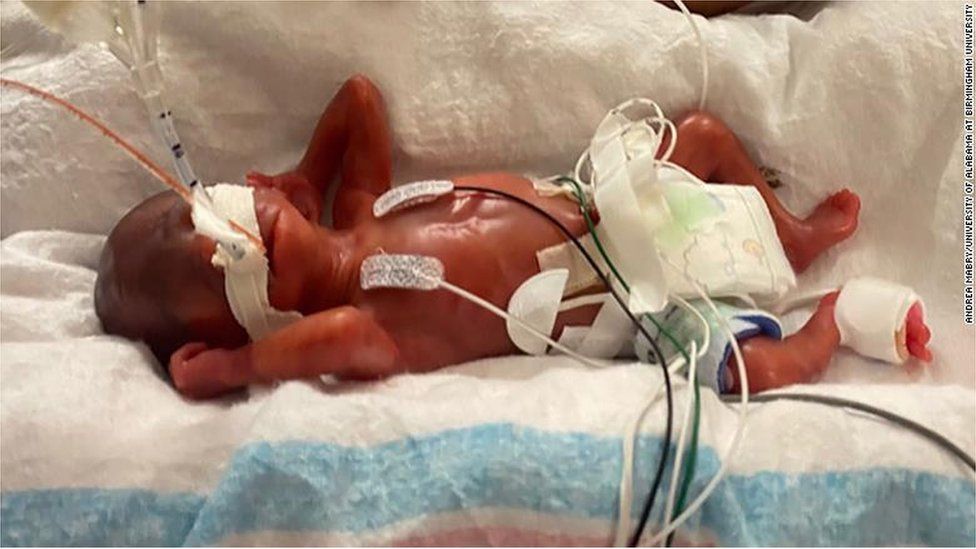When Fatima Goines went into labor at 22 weeks, doctors at Methodist Hospital in Minneapolis told her no hospital could save her baby, that they would deliver her daughter, and that she would be able to hold her infant until she died.
The determined mother, however, left Methodist Hospital and instead checked into a birthing center just seven miles away – one associated with Children’s Minnesota Hospital. After Goines gave birth to her daughter there, Me’Lonii was intubated and placed in an incubator.
The infant’s four-month stay in the NICU included closing a hole in an artery near her heart and observing her gain weight.
Four years later, Me’Lonii is a healthy little girl who has “surpassed all the developmental milestones for her age,” reports the Wall Street Journal.
“She’s doing wonderfully well,” Dr. Thomas George, who directs the Children’s Minnesota neonatal intensive care unit (NICU), told the Journal.
According to the report, doctors are now able to save babies born as early as between 21 and 22 weeks with the aid of “improved techniques to help tiny lungs develop and protect fragile skin and organs.”
Hospitals that have developed extensive protocols for resuscitating very premature babies have reported survival rates of 67% for those born at 22 weeks.
REACH PRO-LIFE PEOPLE WORLDWIDE! Advertise with LifeNews to reach hundreds of thousands of pro-life readers every week. Contact us today.
The bad news, however, is that many U.S. hospitals are poorly equipped to treat babies born this early. Many have elected not to provide such high-level care, telling frantic parents the treatment is very costly and likely to fail. Even if a very premature infant survives, they could face some lasting disabilities, parents are told.
“[P]arents often aren’t aware of what’s possible or that other hospitals, even just a few miles away, might offer their newborns a fighting chance,” the Journal noted, reporting that a spokesman for Methodist Hospital said of Goines’ delivery: “Our team thoughtfully communicated the options available to her.”
Nevertheless, according to the report, the hospital “said it attempted to arrange a transfer at her request, but failed, the spokesman said.”
In June 2023, the smallest baby ever born to date at St. Francis Hospital in Hartford, Connecticut, was discharged after having been delivered at 22 weeks and cared for in the NICU for four months.
Weighing just 12.4 ounces at her birth, with the help of her NICU team, Zahraliz Francis Angueira overcame the odds and grew to 7 pounds, 5 ounces at the time of her discharge, the hospital reported, adding in a press statement:
Over the past four months, Zahraliz has become the hospital’s “miracle” baby as colleagues have rallied to support her and her mom … in an emotional celebration, Saint Francis colleagues, including many of the doctors, nurses, and other staff who helped care for Zahraliz, gathered in the hospital Rotunda to provide well wishes to the family as they embarked on their journey home.
CatholicVote reached out for an update from St. Francis Hospital and will report any further information.
Michael Litten, the founder of the nonprofit Foundation for Premature Infants, told CatholicVote that his organization provides scholarships to clinicians to keep up-to-date in their training to care for micro-preemies.
“We want clinicians to stay current on best practices, so that they’re aware these little ones can be saved at 22 weeks,” he said.
“I was just down in Orlando attending a corporate event where the corporation had given money to the foundation, and I was a keynote speaker, and then they presented another check for $5,000 – which is the largest we’d ever received,” he observed. “During the course of my presentation, I made two donations to clinicians from Winnie Palmer Orlando Regional Hospital, and they have a NICU specifically geared for taking care of those 22-weekers.”
A veteran of the healthcare industry for decades, Litten considered why some hospitals are unwilling to treat and care for these small babies. He said that about 10-15 years ago, he discovered that money rules the decision-making.
“[A]t that time, they had a motivation to keep the little people in the NICU as long as possible, because of the way the reimbursement was structured,” he explained. “They really weren’t interested in reducing length of stay. So, my belief – and this is just me talking – if you follow the money, you’re going to get the answer to everything that drives their decisions.”
As an individual, Litten added that while medical science is enabling us to treat and care for babies born at 22 weeks, others in the country are “advocating for abortions up to full term.”
“I mean, the whole thing is just so upside down,” he told CatholicVote.
Premature babies’ survival rate is climbing, reported Stanford Medicine in February 2022. A comprehensive study that examined 10,877 babies born between 2013 and 2018 found “significant improvement in survival of those born between 22 and 28 weeks, compared to the past.”
“Some 78% were rescued, compared to 76% of those born between 2008 and 2012,” the report noted, adding:
Two percent may not sound like much but it translates into many hundreds of infants saved each year.
[E]ven those delivered at 22 weeks – 18 weeks early – had a chance of living. With active treatment, about 28% of them survived; among those born at 23 weeks, 55% survived.
Co-authors Krisa Van Meurs, M.D., a neonatologist and emerita professor of pediatrics at Stanford Medicine, and Susan Hintz, M.D., professor of pediatrics, marveled at the results they saw in their research.
“When I was in residency in the mid-1980s, babies born at 500 grams [about 1.1 pounds] and 25 weeks didn’t survive; it just didn’t happen,” Van Meurs said. “Now we see the borderline of viability dropping to 22 weeks. With all of these new treatment strategies we’ve developed, we’ve seen an amazing impact.”
With the study’s results showing that even infants at the lowest gestational ages – 22 and 23 weeks – might survive if they are actively resuscitated, Hintz added: “There has been a shift toward considering a more active initial treatment in prenatal discussions with families over the past several years in light of increasing data to support this approach.”
The Journal, however, cites a JAMA Network study this year that found only about 45% of NICU’s in the United States provided treatment to babies at 22 weeks – or “micro-preemies.” The report explained:
NICUs are classified into four levels, depending on the type of care they can provide, with only Levels 3 and 4 equipped to treat babies born before 32 weeks. Even some of the higher level NICUs aren’t caught up on what is now possible or how best to care for such small babies.
Parents faced with a premature birth, nevertheless, may not be aware of which hospitals offer treatment for very early infants. Members of a Facebook group called TwentyTwoMatters shared some of their stories with the Journal. The group has created a map of hospitals that are known to have offered care for a baby as early as 22 weeks.
LifeNews Note: Susan Berry writes for CatholicVote, where this column originally appeared.








